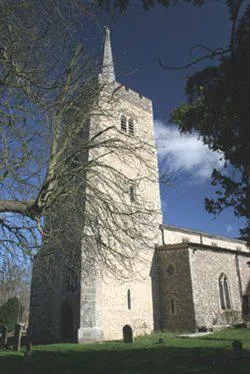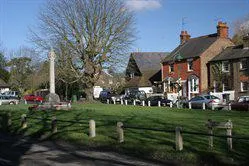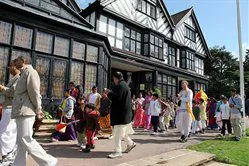This secluded little village remains unspoilt and the parish itself is largely unchanged since Saxon times when the majority of the land was owned by the Abbots of Westminster Abbey.
Aldenham is mentioned in the Domesday Book and is one of the Hertsmere's 14 conservation areas. After the Reformation the lands were sold off to the highest bidders and Aldenham is probably smaller today than it was 500 years ago.
The Church of St John the Baptist in Aldenham is 700 years old and there is good reason to believe that an earlier Saxon church

stood on the site. Complete rebuilding took place around 1250 and substantial portions of this structure can still be seen. The 14th century saw the building of the south aisle followed some 100 years later by the north aisle, with the splendid painted oak ceiling of the nave finished just a few years later.
The interior of the church boasts some interesting features, notably monuments to two ladies of the Crowmer family who lie peacefully in the costume of the 14th century and the reclining figures of John Coghill and his wife who died within a few weeks of each other in 1714.
In 1940 enemy action damaged stained glass and removed the 'Hertfordshire Spike' - the spire on the top of the tower. Restoration work was completed in 1951.
Close to the church stand a number of buildings of historical interest. The earliest of these is Aldenham Social Club - a late medieval hall house dating from around 1500.
To the west of the churchyard stands Church Farm House (16th - 18th century) and to the east the old vicarage (now two dwellings), a fine example of early 18th century red brick architecture.
North of Aldenham stands Wall Hall, situated amid woodland extending to the River Colne. Built in Gothic style at the beginning of the 19th century around an ancient farmhouse, it was bought by the American financier J. Piermont Morgan Jr. in 1912 as a holiday residence. In the Second World War it formed a temporary home for the US Ambassador Joseph Kennedy, father of the late President John Kennedy.
Aldenham School, founded in 1597, is an independent school for boys and girls from two to 18 years. Haberdashers' Aske's School is situated in Aldenham House.
Aldenham Reservoir is an outstanding feature of the area. It was built by the Grand Union Canal Company to assist and regulate water levels in the River Colne. The reservoir is becoming popular for activities such as sailing, windsurfing and fishing.
People can also enjoy the facilities at Aldenham Country Park, pictured below, which offers the opportunity for country walks and picnics.

East of Aldenham village is Round Bush, a hamlet where three roads meet at a welcoming public house. On Hilfield Lane, Patchetts Green is an attractive hamlet of several historic houses including the Three Compasses public house, Little Patchetts Green Farm and Patchetts Farm.
Further south is the appealing village of Letchmore Heath, right, most of which is a conservation area. The village possesses some interesting timber frame houses. Jasmine Cottage and the Three Horseshoes public house are late medieval, the Old Rest and Apple Tree Cottage are 16th century and the Old Bakery is 17th century.

Bhaktivedanta Manor, formerly Piggotts Manor, is now occupied by the International Society for Krishna Consciousness. It is a neo-Tudor building, pictured left, which dates from around 1884. The house was bought more than 20 years ago by former Beatle George Harrison. He gave it to the Krishna movement and today it is used as a college for those wishing to study the movement's philosophy.